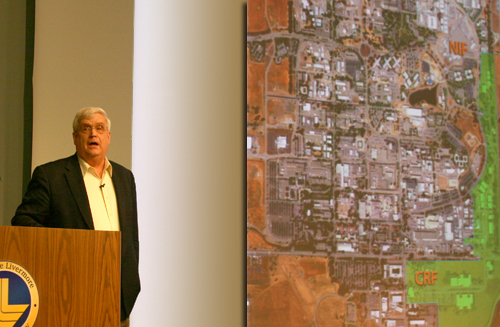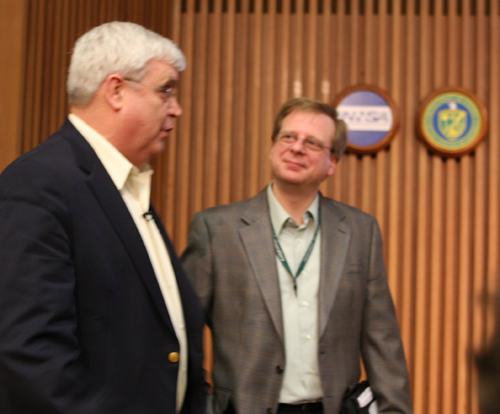Miller sees opportunity amid uncertainties
Director George Miller reassured employees in an all-hands address Monday that despite economic and budgetary uncertainty, the Laboratory has opportunities to contribute to DOE/NNSA missions important to the nation’s security and economic recovery.
Describing the budget situation as "complicated," Miller said Congress would either pass an omnibus appropriations bill or extend the continuing budget resolution, which expires in March. "We do not anticipate significant priority changes for our work mid-year."
Addressing rumors at the conclusion of his presentation, Miller said reports of additional workforce reduction are unfounded based on current budget projections. He also quelled a rumor that the Lab is facing a budget shortfall. "We have enough money to cover all Lab costs, including our current indirect and direct work force and subcontractors," Miller said.
He noted that news organizations have reported a request within that budget to study moving NNSA, or at least parts of it, to the U.S. Department of Defense. "We will continue to highlight the world-class capabilities of our people and facilities and our continued critical scientific and technological contributions to our nation’s security," Miller said, noting the Lab has participated in similar studies before. "In a recent interview, Secretary Chu was quoted as saying that science programs at DOE’s weapons labs are a critical component of DOE’s overall mission and that ‘whatever happens, the science component ...cannot be separate’ from DOE."
Engaging the new administration
"We’ve engaged the new administration on a broad range of missions and we’re working hard to show the breadth of the Laboratory’s capabilities," Miller said. "We’ve begun interacting with DOE and NNSA in the area of energy and climate change and are looking to expand existing programs in those areas."
While the 2009 Economic Recovery Act did not provide direct funding to NNSA, a substantial amount of money was allocated to "our other sponsoring organizations," notably DOE’s Office of Science, Miller said. "There’s opportunity for the Lab to provide R&D in such areas as energy efficiency, renewable energy and fossil fuels."
The stimulus bill reflects the new administration’s priorities in climate research and energy, Miller said. Many of these efforts within the Laboratory are focused in the Global Security Directorate under Doug Rotman. "We are accelerating our outreach to the organizations with responsibility in these research areas with the goal of broadening our current work and starting new R&D areas consistent with our S&T capabilities. We’re broadly engaged in such energy research areas as coal gasification and carbon sequestration."
Miller said he looks forward to working with new Secretary of Energy Steven Chu. "He brings outstanding credentials including a Nobel Prize in physics and personal interest in energy and global climate change," he said. "I’ve worked with Steve as part of the Secretary’s National Laboratory Director’s Counsel and with the other laboratory directors and received a phone call from him on his confirmation day. He welcomes an even stronger relationship and looks forward to working with us."
This week, the three NNSA laboratory directors met with Chu for the annual assessment of the health of the nuclear weapons stockpile.
Tom D’Agostino has agreed to continue leading NNSA until the administration selects a new administrator, Miller said. "This is good news as it provides NNSA and the labs with continuity of leadership."
In a related development, Jonathan George, NNSA acting head of Defense Programs, will move to the White House to serve on the National Security Council, according to Miller. "We’re sorry to see him leave NNSA, but having someone at that level who knows about the Laboratory’s capabilities is very important."
Nation’s strategic future
Miller said upcoming meetings and reviews, in which the Laboratory will play a role, will be part of a "robust national discussion" of the nation’s strategic future. These include the: Quadrennial Defense Review; Nuclear Posture Review; Renewal of the Strategic Arms Reduction Treaty; Non-Proliferation Treaty Review; the Comprehensive Test Ban Treaty; and the development of an approach to sustaining the nuclear weapons stockpile.
"The Lab will support many of these studies and reviews, and contribute to the technical assessment of potential policy decisions," Miller said.
In addition, Miller said the five-year strategic roadmap effort currently under way is vital to the Laboratory’s ability to "make a difference" to the security of the country in a range of areas including: stockpile stewardship science; nuclear counter-terrorism and forensics; biosecurity; cyber, space security and intelligence; advanced lasers and applications; regional climate modeling and energy technology; and Laser Inertial Fusion-Fission Energy (LIFE).
"I’m excited by what I’ve seen," Miller said. "We’re going to invest in this roadmap. These investments are critical to the future of the Laboratory and its ability to continue to fulfill its commitment to help the country solve our most pressing challenges."
Open campus
In order to open up the Laboratory and facilitate interactions with a broader set of sponsors and collaborators, LLNL and Sandia are exploring the creation of an "open campus" — an area that would have its own entrance, separate security and information technology, and would be as open as DOE Office of Science labs or an industrial park, according to Miller. Initial plans are to include Sandia’s Combustion Research Facility and a NIF-related High Energy Density Science Center.
Cost savings
Miller said the Lab has made significant progress in becoming more efficient and cost-effective. Cost saving successes include: reduced support costs in excess of $75 million; 10 percent reduced energy usage; and the cost of an average FTE for FY09 is comparable to FY07.
"A lot of people have worked very hard and did an outstanding job to make this happen — but we’re not done," he said. "We will continue our efforts to find more efficient ways of delivering our mission to the country."
Safety
Injury rates continue to drop, Miller said, noting a three-fold reduction in lost time injury rates — the more serious injuries since they require time off from work.
"While our injury rates have been going down we also are seeing a worrisome increase in events that could have resulted in serious injury," he said. "These events remind us how important it is to pay attention to our work environment, be familiar with the potential hazards of the work and to stop work if we are unsure about how it is to be done or if it can be done safely."
Miller said the Lab has accelerated its beryllium sampling and awareness campaigns in response to "a troubling increase in the number of Lab employees that have been shown to be sensitized to beryllium, starting in 2006."
"We are putting controls in place for work in buildings known or suspected to contain beryllium, are providing additional training for workers and supervisors and we are bringing in nationally recognized experts to help us," Miller said.
Security
Along with other labs in the DOE complex, the Laboratory continues to address a constant barrage of cyber security threats, Miller said. "It is an area where constant vigilance and questioning of our practices is mandatory. We have information and systems that our adversaries would love to get access to and we are under attack thousands of times a day."
Miller reminded employees that a cyber security team assembled last year continues to work on strengthening the Lab’s cyber defenses. Ken Neves was appointed chief information adviser to council Miller and Los Alamos Director Michael Anastasio on addressing new and emerging cyber threats.
"Some of the cyber measures that have been put in place, such as no Web mail access or easy access to external URLs, may seem inefficient or inconvenient," Miller said. "I understand the frustrations and inefficiencies that they cause, but I ask for your patience and, more importantly, your careful thought as we try to combat this real threat."
In concluding his presentation, Miller reflected on the important role the Laboratory must continue to play in the nation’s security and the importance of seeing hope and opportunity in difficult times.
"Every day we are bombarded with a litany of serious issues facing our country. Our new president, who ran on a platform of optimism, hope and enthusiasm for the future, has begun to deal with those issues. In the president’s messages we can see opportunities and hope for solutions," Miller said. "We expect him to deal with them with the seriousness that they deserve — thoughtfully, decisively and head-on. The president expects no less of us.
"I stand in awe at the scientific, technological and operational capability of this Laboratory. We indeed are only limited by our own imagination," he said, emphasizing that employees are the key to the Laboratory’s future success. "That is a truly awesome responsibility. I firmly believe that if we hold true to our values, lean forward and apply our talents and creativity to the country’s most pressing issues, that we will be successful."







